Unit1__第三课时导学案
新外研版八年级英语下册导学案Module 2-Experiences(Unit1-Unit3)
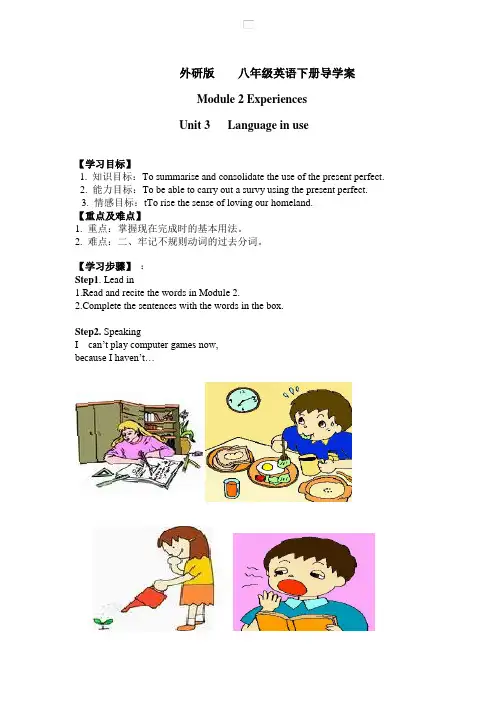
外研版八年级英语下册导学案Module 2 ExperiencesUnit 3 Language in use【学习目标】1. 知识目标:To summarise and consolidate the use of the present perfect.2. 能力目标:To be able to carry out a survy using the present perfect.3. 情感目标:tTo rise the sense of loving our homeland.【重点及难点】1. 重点:掌握现在完成时的基本用法。
2. 难点:二、牢记不规则动词的过去分词。
【学习步骤】:Step1. Lead in1.Read and recite the words in Module2.plete the sentences with the words in the box.Step2. SpeakingI can’t play computer games now,because I haven’t…Step3. Write a questionnaire about your experiences.Have you ever …had a Western meal?lived in another city?entered a singing competition?travelled by train?travelled to the seaside?tried seafood?cooked dinner for your parents?------Yes, I have. / No, I haven’t.Step4 Complete the sentences.1. He/She _____________________ a Western meal.2.He/She ______________________ in another city.3.He/She ______________________ a singing competition.4. He/She _____________________ by train.5.He/She ______________________ the seaside.6.He/She ______________________ seafood.7.He/She ______________________ for his/her parents.Step5. Complete the postcard. Use the list of Things to do in China to help you.Things to do in China!------go to Beijing,see the Beijing Opera,climb the Great Wall,eat Beijing duck,visit the Palace MuseumStep6 Activity4Dear David,I’m having a wonderful time in China. I’ve done so many things!I’ve__________________________________________________________________________________ ___________________________________________________________ There’s only one thing I haven’t don e :I...______________________________________Bye for now,RobStep7. Complete the sentences with the words in the box.afford, competition, pronounce, spell, tower1.I wrote a story for a(n) ___________ in my English class and I won a prize.2.Alice can _______ very well, and what's more, she can write beautifully.3.Some English words are difficult to ____________.4.We visited an ancient palace with a tall_______ and a beautiful garden.5.Mary wants to visit the US, but the plane tickets are very expensive and she cannot ______ to go.Step8.Listen and check (√) the correct answer.Places visitedPeople China Europe USAWinnieDianaBobStep9. Listen again and answer the questions.1. ( ) How many times has Winnie been to the US?A. two timesB. three timesC. four times2. ( ) Where would Diana like to go again?A. the USB. EnglandC. China3. ( ) Which part of China has Diana travelled around?A. NorthB. SouthC. West4. ( ) How did Diana travel there?A. by boatB. by trainC. by plane5. ( ) Has Bob ever visited Germany?A. No, he hasn’tB. Yes, he has【知识结构】(一)、Grammar现在完成时如果你想说“我已经看过某部电影,所以不想看了” “某人曾经做过什么事情”等等,该如何表达呢?首先请看下面的句子:(1)I have seen the f ilm. I don’t want to see it again.(2) Have you ever read a travel brochure?(3) I have never visited the USA.以上句子的谓语动词有一个共同的特点就是“have/has+动词的过去分词”, 用于表示在以前的某个时间曾经做过的、发生的事情,这种行为对目前有某种影响,如(1); 还可以表示到目前为止曾经经历或没经历的事情,如(2)(3)。
人教版五年级上册英语unit1第三课时教案
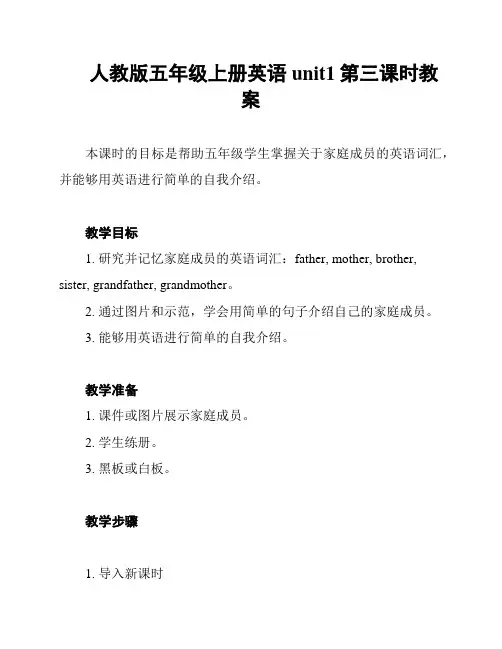
人教版五年级上册英语unit1第三课时教案本课时的目标是帮助五年级学生掌握关于家庭成员的英语词汇,并能够用英语进行简单的自我介绍。
教学目标1. 研究并记忆家庭成员的英语词汇:father, mother, brother, sister, grandfather, grandmother。
2. 通过图片和示范,学会用简单的句子介绍自己的家庭成员。
3. 能够用英语进行简单的自我介绍。
教学准备1. 课件或图片展示家庭成员。
2. 学生练册。
3. 黑板或白板。
教学步骤1. 导入新课时- 出示家庭成员的图片,引导学生复并说出英文单词。
2. 研究家庭成员的词汇- 展示图片,逐个介绍家庭成员的词汇,并教授正确的发音和拼写。
- 学生重复跟读并模仿发音。
3. 配对练- 将学生分为小组,让他们根据课本中的图片进行配对练,说出正确的家庭成员名称。
4. 自我介绍练- 出示一张包含家庭成员的图片,并示范用英语进行自我介绍:"My name is [学生姓名]. This is my [家庭成员]. His/Her name is [家庭成员姓名]."- 学生根据示范进行自我介绍练,老师在班级中给予指导和帮助。
5. 针对个别学生的辅导- 针对表现不够好的学生,进行个别指导和辅导,帮助他们掌握家庭成员的词汇和简单的自我介绍。
6. 总结和复- 通过思维导图、口头问答或其他互动方式,复本课时所学的家庭成员词汇和自我介绍句型。
课后作业1. 完成课本上有关家庭成员的练题。
2. 让学生自己设计一个家庭成员的海报,用英语写出每个家庭成员的名称并进行自我介绍。
以上是对《人教版五年级上册英语unit1第三课时教案》的编写。
根据教学目标和教学步骤,学生将能够掌握家庭成员的英语词汇,用英语进行简单的自我介绍。
教师可以根据学生的实际情况进行灵活调整和适当拓展。
新外研版八年级英语下册导学案-Module 5 Cartoons(Unit1-Unit3)
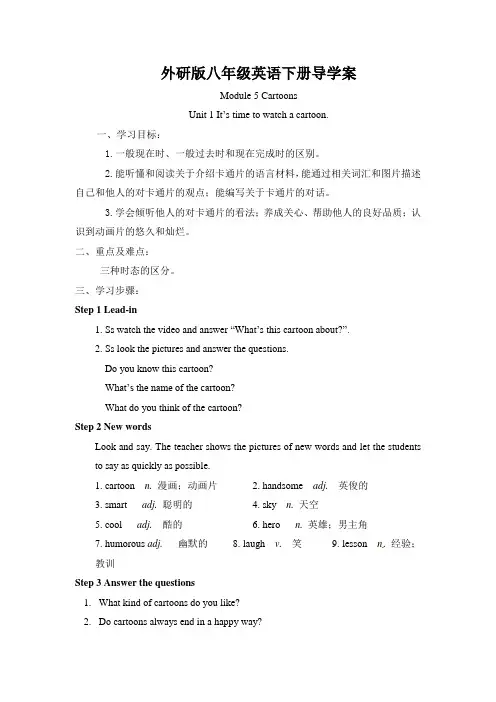
外研版八年级英语下册导学案Module 5 CartoonsUnit 1 It’s time to watch a cartoon.一、学习目标:1.一般现在时、一般过去时和现在完成时的区别。
2.能听懂和阅读关于介绍卡通片的语言材料,能通过相关词汇和图片描述自己和他人的对卡通片的观点;能编写关于卡通片的对话。
3.学会倾听他人的对卡通片的看法;养成关心、帮助他人的良好品质;认识到动画片的悠久和灿烂。
二、重点及难点:三种时态的区分。
三、学习步骤:Step 1 Lead-in1. Ss watch the video and answer “What’s this cartoon about?”.2. Ss look the pictures and answer the questions.Do you know this cartoon?What’s the name of the cartoon?What do you think of the cartoon?Step 2 New wordsLook and say. The teacher shows the pictures of new words and let the students to say as quickly as possible.1. cartoon n.漫画;动画片2. handsome adj. 英俊的3. smart adj. 聪明的4. sky n. 天空5. cool adj. 酷的6. hero n. 英雄;男主角7. humorous adj. 幽默的8. laugh v. 笑9. lesson n.经验;教训Step 3 Answer the questions1.What kind of cartoons do you like?2.Do cartoons always end in a happy way?3.What cartoons do you think are funny?Step 4 Listening1. Listen to Part 2 and find out Betty’s and Tony’s answers to the questions in Activity 1.brave, cartoon, cute, funny, handsome, smart2. Now work in pairs and check. Do they like the same cartoons as you?3. Listen to Part 3 and answer the following questions.1) Wh at are Tony and Daming talking about?2) What does Daming think is better?Answers: 1. They are talking about cartoons.2. He thinks Superman is better.Step 5 Reading1.Now answer the questions.1. What does Tony think about Spiderman?2. Why does Daming think Superman is better?3. Why do they both like Tom and Jerry?4. What lesson can Tony learn from Tom and Jerry?Answers: 1. Spiderman can’t fly, but he climbs up buildings with his hands and feet. That’scool.2. Becaus e he’s stronger th an Spiderman. He can fly though the skyand fight badpeople.3. Because Tom and Jerry are very funny.4. They fight a lot, but t hey really love each other.Step 6 Everyday EnglishLet Ss say what they have learnt in the passage.Step 7 Language pointsSs should master the main points from the passage in Part 3.If possible, let the students to say at first.1. Do cartoons always end in a happy way? 卡通片常以快乐的方式结束吗?in a … way 表示“以一种…的方式”。
人教版英语八年级上第一单元导学案
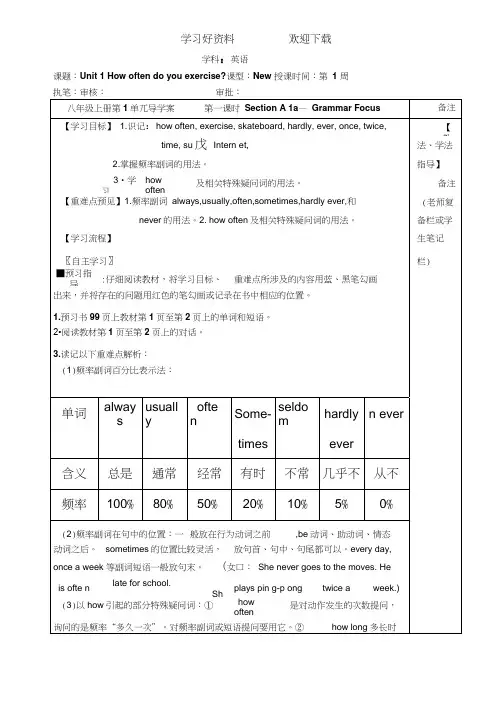
学科:英语课题:Unit 1 How often do you exercise?课型:New 授课时间:第1 周执笔:审核:审批:间,多长”,对一段时间提问用它。
③how soon (过)多久(以后)”,常用于将来时态句中,对in+时间段”提问要用它。
④how far 意为距离有多远”,是指路程的 长度。
(4)exercis e ①可数名词,"练习(题);体操;(一种)运动”。
(如:do one ' s exercises ,do eye exercises )②不可数名词和动词"运动;锻炼” 。
(如:take exercise 运动,I exercise every day. 我每天锻炼。
)。
■预习反馈:认真读记以上内容,完成下列习题〖合作探究〗:■活动1:翻译并读记下列频率副词、副词短语及句子:(1) ____________ 通常______________ ⑵有时 ____________ ⑶总是 ________ ⑷从不 ⑸经 常 _________ (6)几乎不 ____________ (7)不常 __________ (8)每天 _______________ (9) 一周一次___________________ (10) 一月两次 __________________ (11)一年三次 ___________ (12)她几乎不打篮球。
_____________________ (13)他每天吃蔬菜。
__〖问题〗 ____________________________________________________________ 〖小结〗 ____________________________________________________________活动 2: 对戈卩线部分提问 :(1) Tom never exercises. ______________________(2) ______________________________________________________________ He stayed here for two weeks. _________________________________________________________(3) ______________________________________________________________ Jim will come back in an hour. __________________________________________________________ (4) ______________________________________________________________ It "s 1500 kilometers (公里)from Chongqing to Beijing. ______________________________〖问题〗 ____________________________________________________________ 〖归纳〗 ___________________________________________________________ 〖过关检测〗 用频率副词代替划线部分改写句子(解题思路举例:six times amonth f 6/30 ~ 20/100 即:sometimes ): 1. I get up at six thirty every day . month .2. Peter watches TV five times a week .3. Jim walks to schoolfour days a 4. Bob exercises once a month .6.Tom doesn 'eat apples.7 . Lucy exercises fifteen times a month . Lucy【中考链接】1.— _______ do you have an En glish party? — Once a mon th.(北京)A. How soo nB. How farC. How ofte nD. How longI get up at six thirty .Peter watches TV . Jim walks to school Bobexercises .Gi na plays tennis . Tomeats apples. exercises .ith.2. —is “ Lucky 52 ” shown o2?CCTVfery week. (20XX 年,黄冈)八年级上第1单元导学案第三课时Section B 3A—4【学习目标】1.掌握以下重点词语的用法:try, look after, better. same, as,different/differenee, maybe/may be, although=though 。
【人教版PEP小学四年级英语上册教案】Unit 1 导学案 3
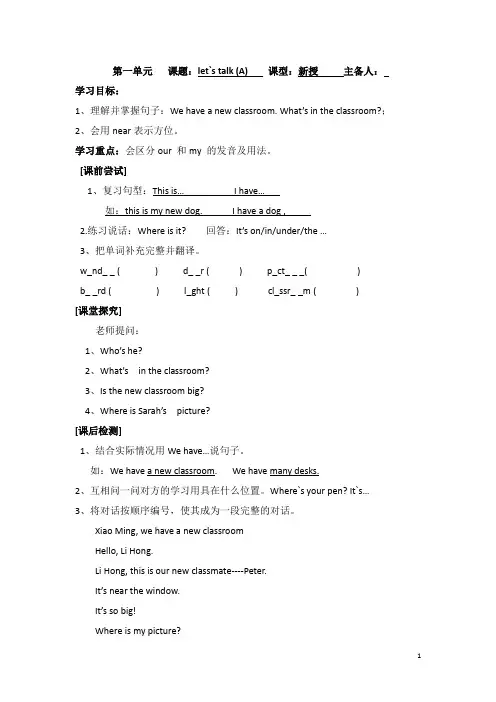
第一单元课题:let`s talk (A) 课型:新授主备人:学习目标:1、理解并掌握句子:We have a new classroom. What’s in the classroom?;2、会用near表示方位。
学习重点:会区分our 和my 的发音及用法。
[课前尝试]1、复习句型:This is… I have…如:this is my new dog. I have a dog ,2.练习说话:Where is it? 回答:It’s on/in/under/the …3、把单词补充完整并翻译。
w_nd_ _ ( ) d_ _r ( ) p_ct_ _ _( )b_ _rd ( ) l_ght ( ) cl_ssr_ _m ( )[课堂探究]老师提问:1、Who’s he?2、What’s in the classroom?3、Is the new classroom big?4、Where is Sarah’s picture?[课后检测]1、结合实际情况用We have…说句子。
如:We have a new classroom. We have many desks.2、互相问一问对方的学习用具在什么位置。
Where`s your pen? It`s…3、将对话按顺序编号,使其成为一段完整的对话。
Xiao Ming, we have a new classroomHello, Li Hong.Li Hong, this is our new classmate----Peter.It’s near the window.It’s so big!Where is my picture?Nice to meet you, too.Hello, Xiao Ming.Nice to meet you.Let’s go and see.Ok.Wow![作业设计]一、选择填空。
1. What colour is the ball?( )A.It’s big.B. It’s blue.C. It’s near the window.2. What’s in your classroom?( )A.This is a desk. b.It’s nice.c.A board, two lights, many desks and chairs.3. Where are your pencils? ( )A. I have many bags.B. They are heavy.C. They are in my bag.4. Where is my seat?( )A. It’s in the desk.B. It’s near the window.二、练习句子:We have…第一单元课题:let`s lean A 课型:新授主备人:学习目标:1、理解句子:What’s in the classroom?2、能够听、说、认、读classroom, window, door, picture, blackboard, light等单词。
七年级英语上册 Unit 1 My name is Gina(第3课时)导学案3(无答案)(新版)人教新目标版
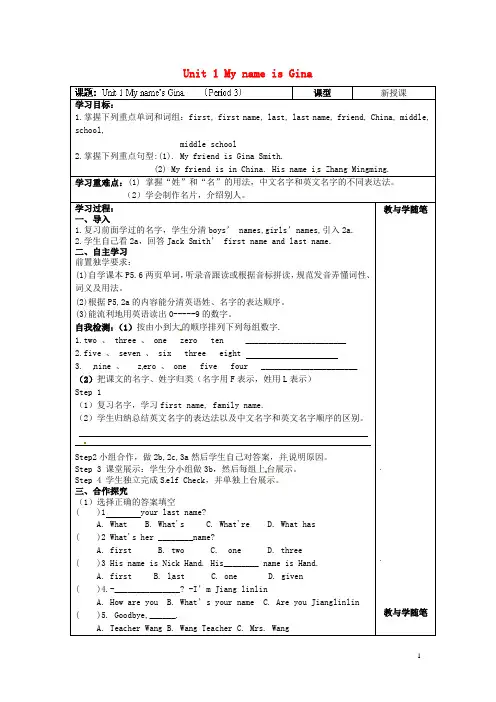
Step2 小组合作,做 2b,2c,3a 然后学生自己对答案,并 说明原因。 Step 3 课堂展示:学生分小组做 3b,然后每组上 台展示。 Step 4 学生独立完成 S elf Check,并单独上台展示。 三、合作探究 (1)选择正确的答案填空 ( )1 your last name? A. What B. What's C. What're D. What has ( )2 What's her ________name? A. first B. two C. one D. three ( )3 His name is Nick Hand. His________ name is Hand. A. first B. last C. one D. given ( )4.-_______________? -I’m Jiang linlin A. How are you B. What’s your name C. Are you Jianglinlin ( )5. Goodbye,______. A. Teacher Wang B. Wang Teacher C. Mrs. Wang
Unit 1 My name is Gina
课型 新授课 学习目标: 1.掌握下列重点单词和词组:first, first name, last, last name, friend, China, middle, school, middle school 2.掌握下列重点句型:(1). My friend is Gina Smith. (2) My friend is in China. His name i s Zhang Mingming. 学习重难点:(1) 掌握“姓”和“名”的用法,中文名字和英文名字的不同表达法。 (2)学会制作名片,介绍别人。 学习过程: 教与学随笔 一、导入 1.复习前面学过的名字,学生分清 boys’ names,girls’names,引入 2a. 2.学生自己看 2a,回答 Jack Smith’ first name and last name. 二、自主学习 前置独学要求: (1)自学课本 P5.6 两页单词, 听录音跟读或根据音标拼读, 规范发音弄懂词性、 词义及用法。 (2)根据 P5,2a 的内容能分清英语姓、名字的表达顺序。 (3)能流利地用英语读出 0-----9 的数字。 自我检测: (1)按由小到大 的顺序排列下列每组数字. 1.two 、 three 、 one zero ten _______________________ 2.five 、 seven 、 six three eight 3. nine 、 z ero 、 one five four ______________________ (2)把课文的名字、姓字归类(名字用 F 表示,姓用 L 表示) Step 1 (1)复习名字,学习 first name, family name. (2)学生归纳总结英文名字的表达法以及中文名字和英文名字顺序的区别。
2024年新版人教版七年级上册英语Unit 1(第3课时 Section A)(导学案)
1.What kind of questions are they?__________________________________________________2.Read the sentences and circle the verbs.Then write am,is or are next to the personal pronouns.3.Do you find the rules about the use of be verbs ?________________________________________________________________________4.Practice 将下列主语与be动词搭配5.含有be动词的句子怎么变成一般疑问句?I am a student.________________________________________________________________6.Practice 将下列句子改为一般疑问句,并做肯定和否定回答。
①She is Linda._____________________________________________________________________________②I am from China._____________________________________________________________________________Introduce one of your new friends to a partner.一、用am,is,are填空1.What kind of questions are they?含有be动词的一般疑问句/ 由特殊疑问词引导的特殊疑问句2.Read the sentences and circle the verbs.Then write am,is or are next to the personal pronouns.3.Do you find the rules about the use of be verbs ?I(我)用am, you(你)用are,is 跟着she (她),he(他),it(它),单数一律用is,复数一律都用are。
九年级英语导学案Unit 1
九年级英语导学案Unit1 How can we become good learners?第一课时(sectionA 1a—2d)主备人:曹小燕审核:左瑞一、学习目标:1、知识与能力:学习并掌握:key words: textbook, conversation, aloud, pronunciation, sentence, patient.Key phrases: listen to tap es, ask … for… , study with a group, haveconversations with … , read aloud, speaking skills, spoken English, give areport, word by word , more than .Sentence patterns: ----How do you study … ? ---I study by … .Have you ever…?The more…, the +比较级2、过程与方法:听说练习3、情感态度与价值观:借鉴文中提供的学英语的方法,提高学习兴趣,取得好成绩。
二、教学重点:基本词汇的学习掌握。
三、教学难点:易混词辨析:loud,aloud, loudly;难句解读。
四、教学过程:1、出示学习目标;预习导学:检测课本1、2页单词并完成1a 短语翻译;导学释疑:(一)翻译下列词组。
1. by making word cards2. have conversations3 read aloud ________ 4. practice pronunciation ________________5. spoken English6.通过向老师求助7.通过读课本8.说的技巧9 小组学习10.听磁带(二)回答问题。
1How do you usually study English ? (At least 3 ways)2.Which way do you think is the best ? Why ?5、达标检测:选择。
九年级英语上册 Unit 1 Stay Healthy Lesson 3 Good Food, G
九年级英语上册Unit 1 Stay Healthy Lesson 3 GoodFood, GoodHealth导学案(新版)冀教版编辑整理:尊敬的读者朋友们:这里是精品文档编辑中心,本文档内容是由我和我的同事精心编辑整理后发布的,发布之前我们对文中内容进行仔细校对,但是难免会有疏漏的地方,但是任然希望(九年级英语上册Unit 1 Stay Healthy Lesson 3 Good Food, Good Health导学案(新版)冀教版)的内容能够给您的工作和学习带来便利。
同时也真诚的希望收到您的建议和反馈,这将是我们进步的源泉,前进的动力。
本文可编辑可修改,如果觉得对您有帮助请收藏以便随时查阅,最后祝您生活愉快业绩进步,以下为九年级英语上册Unit 1 Stay Healthy Lesson 3 GoodFood, GoodHealth导学案(新版)冀教版的全部内容。
Les son 3 Good Food,G ood H ealt h【学习目标】1、 学习的任务和目标1) Gra sp th e wo rds :grai n, vitami n, min era l, fi ber , corn , prot ei n, bea n , Asi an,s oy, calcium , bo ne, yog urt, contai n, balanced, die t, include .2、学习的重点1) Rememb er the key p hrases and use the m freely 。
3、学习的难点1) G rasp the k ey struct ure s , le arn how to h ave a balanc ed di et。
.【学习过程】S tep 1: 自主学习-—--明确目标 自学文本1。
请同学们课前上平台阅读思考本节导学案,明确本节课的学习任务和目标.2。
仁爱英语八年级上Unit1Topic3导学案(仁爱版英语八年级)
仁爱英语八年级上Unit 1 Topic 3导学案 (仁爱版英语八年级)Unit 1 Topic 3写出下面动词的过去式1.hit---2.encourage ---3.improve ---4.ring---5.stand---6.take---7.buy---8.join---9.meet---10.hold---11.feel---12.win---Section A一. 写出下面动词的过去式1.hit---2.encourage ---3.improve ---4.ring---5.stand---6.take---7.buy---8.join---9.meet---10.hold---11.feel---12.win---二. 在文中划出下列短语并翻译1.talk about_________________2.take part in________________3.the boys’ 800-meter race________________________4.be good at ________________5.the long jump______________6.the high jump______________7.I hope so. _________________8.cheer ---on________________9.take part in________________10.It’s my first time to do sth_______________________11.be ready for sth___________12.do one’s best_____________13.enjoy doing sth____________14.the boys’ relay race ________15.a pair of running shoes______16.join in _________________17.have fun ________________三. 在文中找到下列句子并翻译总结1.I will take part in the school sports meet. 译:________________________________will + V原表达什么概念:________________________________More examples:⑴ I’ll be in the long jump and the high jump. ⑵ Steve will come to cheer me on.⑶ I believe you will win. ⑷ I’m sure the sports meeting will be exciting.Please find out more sentences with will + V原 in Section A①______________________________②______________________________③______________________________④______________________________⑤______________________________⑥______________________________找完后,你有没有发现won’t + V原的?Why? 请写出你的答案:______________________以上这么多的例句,到底要表达什么时候发生的动作或状态呢?请回答:______________________试试看!你会翻译下列句子吗?①我会在校门口等你。
- 1、下载文档前请自行甄别文档内容的完整性,平台不提供额外的编辑、内容补充、找答案等附加服务。
- 2、"仅部分预览"的文档,不可在线预览部分如存在完整性等问题,可反馈申请退款(可完整预览的文档不适用该条件!)。
- 3、如文档侵犯您的权益,请联系客服反馈,我们会尽快为您处理(人工客服工作时间:9:00-18:30)。
Unit1 第三课时导学案
My body
教学目标:
一.学习“四会”单词:hand, body, foot, arm, leg, hair 并用所学单词和句型描述自己身体的各个部位。
二.学习Does it have …句型及其肯定和否定回答。
教学重点:
能听懂、会写、会读、会说hand, body, foot, arm, leg, hair。
教学难点:
掌握Does it have …句型及其肯定和否定回答。
教学环节:
•学习目标(2分钟)
(一)学习“四会”单词:hand, body, foot, arm, leg, hair 并用所学单词和句型描述自己的五官。
(二)学习Does it have …句型及其肯定和否定回答。
•自主学习(15分钟)
(一)温故知新
完成read and color 的染色练习。
(二)阅读方法
对照课本第4页,边看边练习拼写描述身体部位的单词。
(三)互助释疑
同桌间读对话,理解一般疑问句的用法。
(四)探究出招
小组合作用Does it have …造句,并进行回答。
•展示交流(10分钟)
(一)小组展示
小组内练习用英语描述身体各个部位。
(二)班级展示
指名小组上讲台做游戏,用英语描述自己或者他人身体的各个部位。
•点拨升华(8分钟)
(一)教师放录音,学生跟读,纠正读音。
(二)学生开火车读单词。
(三)小组内分角色读对话。
(四)上台表演对话。
•课堂作业(5分钟)
•作业当堂清
1.单词拼写
h d 手 b dy 身体 f t 脚
l g 腿m 胳膊h r 头发
h d 手 b dy 身体 f t 脚
l g 腿m 胳膊h r 头发
2.单词连线
Hand body foot leg arm hair
手身体脚腿胳膊头发
•挑战自我
3.重新排列句子顺序
( ) Yes, it does. It has two legs and two feet.
( ) No, it doesn’t.
( ) Look at my toy. This is the body. And it has arms and hands.
( ) Does it have hair?
( ) Does it have legs?
板书设计:
Unit 1 My body
hand 手
body 身体Does it have …?
foot 脚Yes, it does./No, it does n’t arm 胳膊
leg 腿
hair 头发。
